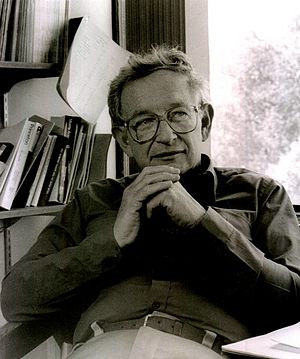Philip W. Anderson facts for kids
Quick facts for kids
Philip W. Anderson
ForMemRS HonFInstP
|
|
|---|---|
 |
|
| Born |
Philip Warren Anderson
December 13, 1923 Indianapolis, Indiana, U.S.
|
| Died | March 29, 2020 (aged 96) Princeton, New Jersey, U.S.
|
| Alma mater | |
| Known for |
|
| Awards |
|
| Scientific career | |
| Fields | Physics |
| Institutions | |
| Doctoral advisor | John Hasbrouck Van Vleck |
| Doctoral students |
|
Philip Warren Anderson (December 13, 1923 – March 29, 2020) was an American theoretical physicist. This means he used math and ideas to understand how the universe works. He was also a Nobel laureate, which means he won a Nobel Prize for his amazing discoveries.
Anderson made many important contributions to physics. He helped us understand how materials behave, especially at a very tiny level. He also worked on ideas like symmetry breaking, which is important for understanding how tiny particles get their mass (this is part of the Higgs mechanism). He also explored emergent phenomena, which is about how complex things can come from simpler parts. Anderson even helped name the field of physics now called condensed matter physics.
Contents
Early Life and Education
Philip Warren Anderson was born in Indianapolis, Indiana. He grew up in Urbana, Illinois. His father was a professor who studied plant diseases. His grandfather was a math teacher. Philip went to high school in Urbana and graduated in 1940.
A math teacher encouraged him to go to Harvard University. He studied "Electronic Physics" and earned his first degree in 1943. After that, he joined the war effort during World War II. He built antennas for the United States Naval Research Laboratory until the war ended in 1945.
After the war, Anderson went back to Harvard. He continued his studies in physics and earned his Ph.D. in 1949. His research was about how gas pressure affects light.
Career and Major Discoveries
From 1949 to 1984, Anderson worked at Bell Laboratories in New Jersey. This was a very important place for scientific research. During his time there, he explored many different problems in condensed matter physics. This field studies the physical properties of matter, like solids and liquids.
Key Ideas and Theories
Anderson developed several big ideas:
- Anderson localization: This idea explains how electrons can get stuck in a material if it's messy or disordered.
- Anderson's theorem: This is about how impurities affect materials that can conduct electricity perfectly (called superconductors).
- Anderson Hamiltonian: This is a mathematical model that helps describe how electrons interact in certain metals.
- Symmetry breaking: He suggested this idea in particle physics. It helped lead to the Standard Model, which describes the basic forces and particles in the universe. It also helped explain the Higgs mechanism, which gives mass to some tiny particles.
- Spin glass: He helped create the study of "spin glasses," which are materials with unusual magnetic properties.
Teaching and Nobel Prize
Anderson also taught at universities. He was a lecturer at Cambridge University in 1961–1962. From 1967 to 1975, he was a professor of theoretical physics at Cambridge.
In 1977, Anderson won the Nobel Prize in Physics. He shared the award with Sir Nevill Francis Mott and John van Vleck. They won for their work on how electrons behave in magnetic and disordered materials. This research was very important for developing electronic devices like computer memory.
After leaving Bell Labs in 1984, he became a professor at Princeton University.
More is Different
In 1972, Anderson wrote a famous article called "More is Different." In this article, he explained an important idea called emergent phenomena. This means that when you put many simple parts together, they can create complex behaviors that you wouldn't expect from just looking at the individual parts. For example, a single water molecule is simple, but billions of them together can form a wave, which is a complex behavior. This idea influenced the study of complex systems.
Later Work and Views
Anderson was involved with the Santa Fe Institute, which studies complex systems. He also spoke to the U.S. Congress in 1987. He argued against building a very large particle accelerator called the Superconducting Super Collider (SSC). He believed it was too expensive and wouldn't provide enough benefits to science. The project was later canceled.
In 2006, a study looked at scientific papers and found that Anderson was one of the "most creative" physicists in the world.
Awards and Honors
Philip Anderson received many awards for his scientific work:
- Oliver E. Buckley Condensed Matter Prize (1964)
- Nobel Prize in Physics (1977)
- Golden Plate Award of the American Academy of Achievement (1978)
- Foreign Member of the Royal Society (1980)
- National Medal of Science (1982)
- Member of the American Philosophical Society (1991)
Personal Life
Anderson was interested in Japanese culture. He lived in Japan for some time and became a master of the board game Go. He even joked that only four people in Japan could beat him at the game! The Nihon Ki-in, a Go organization, gave him a lifetime achievement award in 2007.
Philip Warren Anderson passed away in Princeton, New Jersey, on March 29, 2020, at the age of 96.
See also
 In Spanish: Philip Warren Anderson para niños
In Spanish: Philip Warren Anderson para niños

